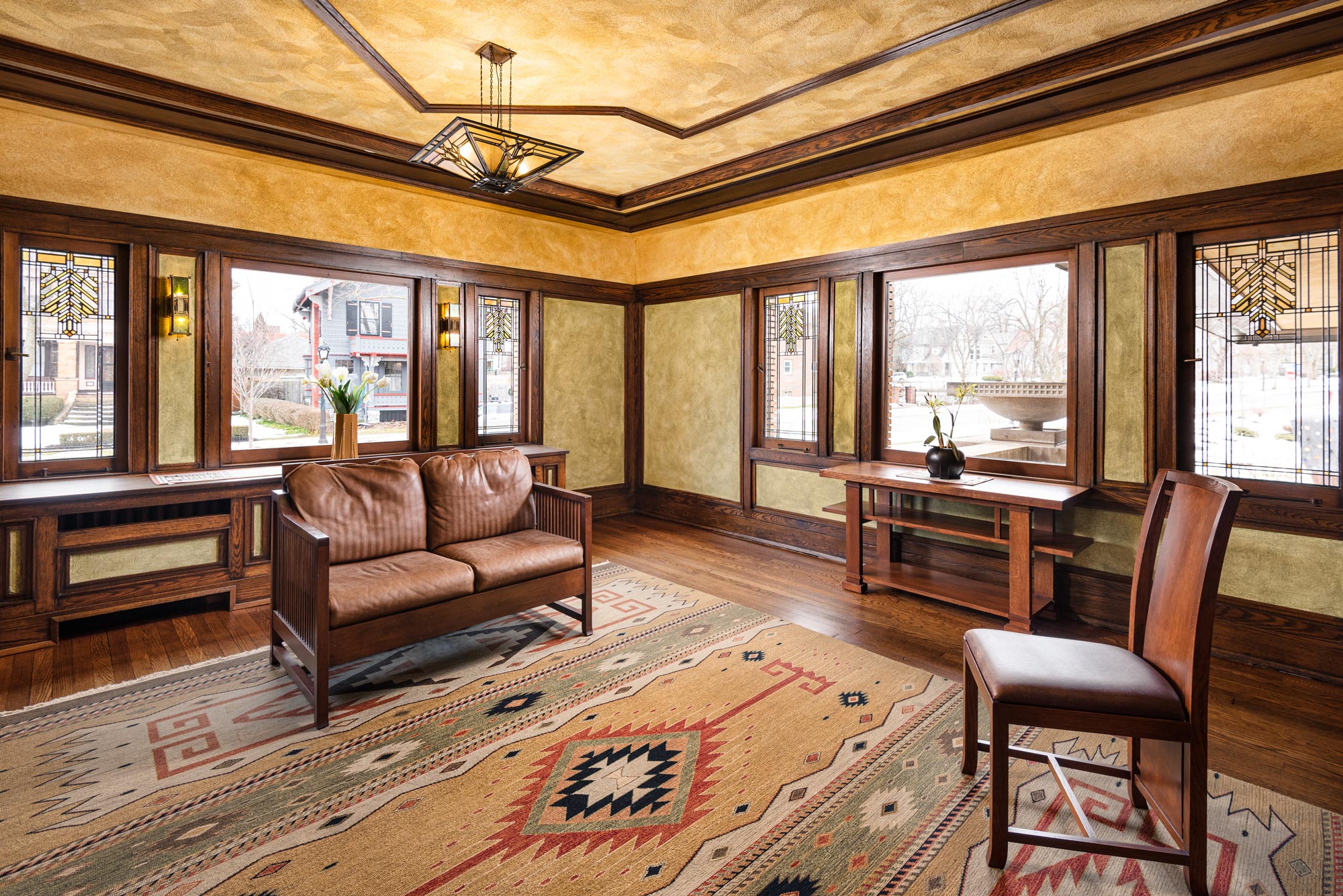The Barton House (1903) is a significant project in Frank Lloyd Wright’s body of work. It was the first dwelling built on the Martins’ multi-residential estate located in the historic Frederick Law Olmsted-designed Parkside neighborhood of Buffalo, New York.
Earning the commission for the George and Delta Barton House opened doors and national recognition for Wright in the Northeast. His portfolio until that point had consisted of Midwest, regional projects from his clients based in Wisconsin and Illinois. Wright’s successful working relationship with Darwin Martin and John Larkin led to his first commercial commission for the Larkin Administration Building as well as the buildings and grounds that make up the Martin House in its entirety.
Over the years, the Barton House has been continuously occupied and treated with excellent stewardship.
Today, the Barton House has completed a $2 million historic restoration, bringing it up to the meticulous standards set by the Martin House. Following extensive research and plans produced by HHL Architects, the pivotal Prairie house has undergone both mechanical upgrades and cosmetic restoration, inside and out. Improvements include updated HVAC, electrical service, and security systems. Restored architectural elements include replaced stucco eaves, masonry and chimney repairs, and the all-important verandah wood floor restored. Inside, original plaster has been repaired or replaced, all interior woodwork and built-in cabinetry refinished, original light fixtures re-wired and repaired, and minor art glass restoration performed.
Rehabilitation of the Barton House completes the restoration of Wright’s buildings on the historic site and returns a pivotal player in Wright’s “Buffalo Venture” to its original glory, enhancing visitors’ enjoyment and understanding of inspired architectural patronage and the distinctive buildings it produced.
Fun Facts About Barton House
- Built in 1903, the Barton House is the oldest structure on the estate.
- The Barton House design is an upgraded version of Wright’s Joseph J. Walser House in Chicago from 1901. The Barton House has a tile roof, brick veneer, and a verandah, which the Walser House does not.
- The Barton House was a test case between Martin and Wright to see if they could work together before earning the commission for the Martin House and the Larkin Administration Building. The house was nearly three times over budget on the Barton House, but the client proceeded with both commissions.
- The Barton House is one of five residences designed by Wright in Buffalo for employees of the Larkin Company [Barton, Martin, Heath, Davidson, Graycliff].
- The Barton House has 100% of its original windows, which were installed inside out when first built, a fact the architect never revealed to his client. The windows remain in their original orientation, and were not reversed during the building’s rehabilitation.
- The original Barton House dining room set (with unusual octagonal chair spindles + legs) is in the collection of the Minneapolis Institute of Art.
- The mouthpiece at the kitchen door exterior and at the top of the second story staircase was a communication system for the ice-man and other service workers to announce to the Bartons when a delivery was being made.
- Following the Barton family’s residency (1904-31), other families occupied the house until Eric and Eleanor Larrabee purchased it in the late 1960s. At the same time, the University at Buffalo purchased the Martin House for President Martin Meyerson. Eric Larrabee was provost during Meyerson’s presidency, and his wife was an architect. The couple were wonderful stewards of the house; they preserved even the smallest piece of original hardware. As a result, the Barton House remains among the most well preserved of any of Wright’s occupied Prairie style houses.
- The Barton House was once the temporary home of Martin House curator emeritus and University at Buffalo professor emeritus, Jack Quinan. Quinan once said, “The fun in living there was letting people in to see the house; people from all over including the famous Italian art collector, Count Ponzi, who I ran into behind the house when I was barefoot, wearing a wife-beater undershirt and carrying out the garage –uh, Hi Count! Not so much fun was trying to read the Sunday paper in the living room when people were looking through the window and wanting to get in. Washing the windows was no fun at all.”
- In 1994, through the patronage of Robert Wilmers (M&T Bank), Robert Rich (Rich Products), and Stanford Lipsey (The Buffalo News), the Martin House Restoration Corporation was able to acquire the Barton House.
- The Barton House used to serve as the visitor center and gift shop from 1998-2006. The dining room of the Barton House was the gift shop. Tours started in the living room, which included a scale model of the Martin House. Visitors would gather around the model as the docent introduced the project and described what was going to happen at the site.









